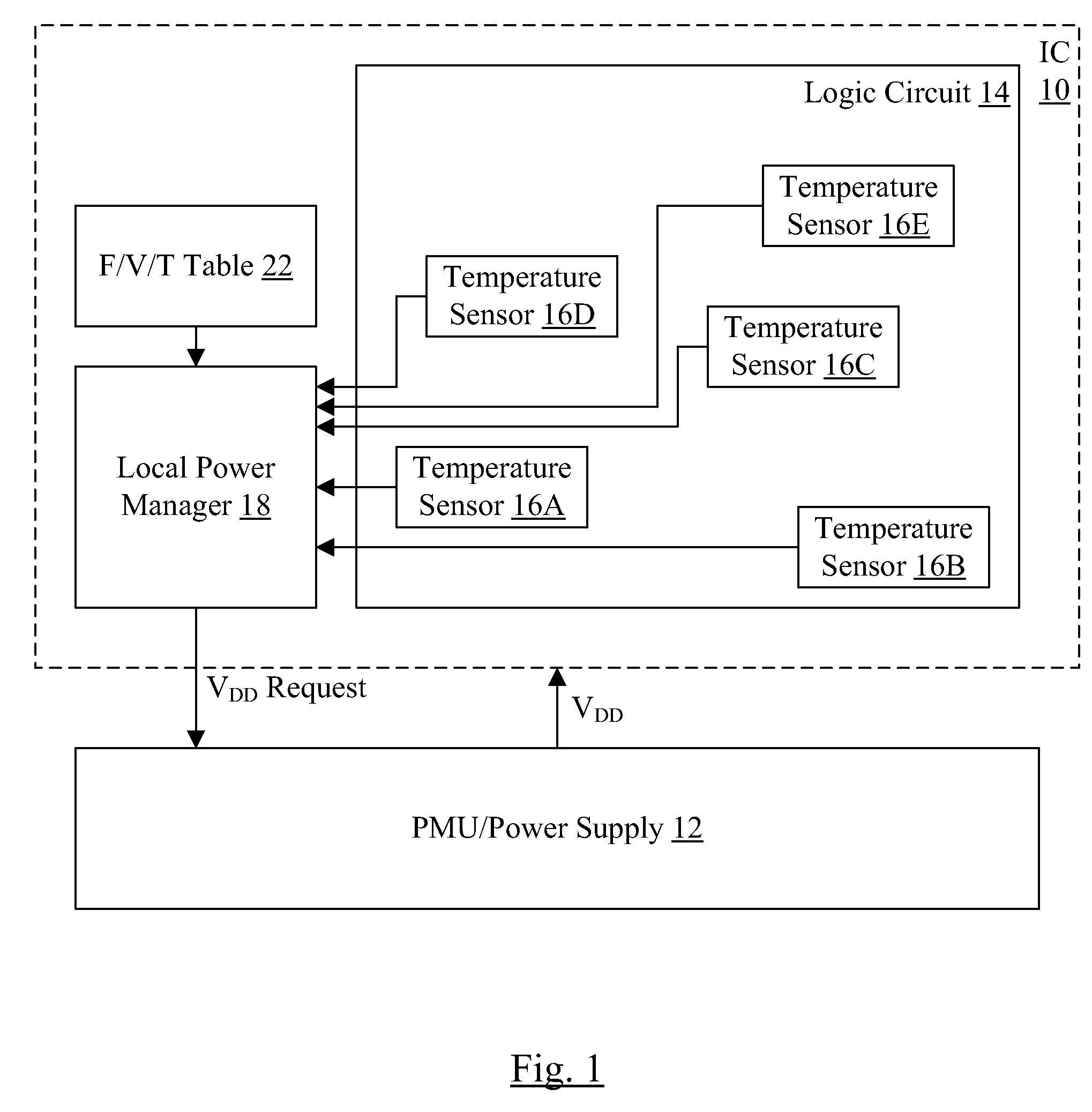Temperature compensation in integrated circuit
a technology of integrated circuits and temperature compensation, which is applied in the direction of automatic control, process and machine control, instruments, etc., can solve the problems of reducing power consumption, overly expensive or even infeasible, and meeting the thermal requirements of integrated circuits
- Summary
- Abstract
- Description
- Claims
- Application Information
AI Technical Summary
Benefits of technology
Problems solved by technology
Method used
Image
Examples
first embodiment
[0037]FIG. 3 is a block diagram of the local power manager 18. In the embodiment of FIG. 3, the local power manager 18 includes optional other compensation unit 40 coupled to receive other compensation inputs from monitor circuitry designed to detect other effects (e.g. aging, supply voltage drop, etc.). Other embodiments many not include additional compensation, as desired. The other compensation unit 40 is coupled to receive the contents of the F / V / T table 22, and is coupled to provide the contents (possibly modified to compensate for the other effects being monitored) to a temperature compensation unit 42. In embodiments that do not include the other compensation unit 40, the temperature compensation unit 42 may be coupled to receive the contents of the F / V / T table 22 directly.
[0038]The temperature compensation unit 42 comprises circuitry that receives the outputs of the temperature sensors 16A-16E and the (possibly compensated) F / V / T information. The F / V / T information may includ...
second embodiment
[0041]Turning next to FIG. 4, the local power manager 18 is shown. In the embodiment of FIG. 4, the F / V / T table 22 may comprise multiple tables, or multiple entries per operating frequency. Each table (or entry) may store a different supply voltage magnitude for a given operating frequency, that corresponds to a different operating temperature or temperature range. Such a table 22 may be provided if the test time during manufacturing permits testing at multiple different operating temperatures, for example. The contents of the F / V / T table 22 may be provided to a mux 46, and the temperature compensation unit 42 is coupled to provide a selection control to the mux 46. The temperature compensation unit 42 may be configured to use the outputs of the temperature sensors 16A-16E to determine the operating temperature, and may be configured to select an supply voltage magnitude for each operating frequency from the table 22 that corresponds to that operating temperature. For example, each ...
third embodiment
[0043]FIG. 5 is the local power manager 18. In this embodiment, the temperature compensation unit 42 is coupled to receive the contents of the F / V / T table 22, and is configured to determine a compensated supply voltage magnitude responsive to the outputs of the temperature sensors 16A-16E. In this case, the output is provided to a mux 48 which is also coupled to receive the output of the other compensation unit 40. In this case, the other compensation unit 40 may even be a “closed loop” compensation unit that determines a supply voltage magnitude based only on the outputs of the corresponding monitor circuits (input to the other compensation unit 40, as shown in FIG. 5). The other compensation unit 40 may output the supply voltage magnitude that it has determined to the mux 48, and may also indicate the supply voltage magnitude to the temperature compensation unit 42. The temperature compensation unit 42 may be configured to override the supply voltage magnitude from the other compe...
PUM
| Property | Measurement | Unit |
|---|---|---|
| temperature | aaaaa | aaaaa |
| temperature | aaaaa | aaaaa |
| operating frequency | aaaaa | aaaaa |
Abstract
Description
Claims
Application Information
 Login to View More
Login to View More - R&D
- Intellectual Property
- Life Sciences
- Materials
- Tech Scout
- Unparalleled Data Quality
- Higher Quality Content
- 60% Fewer Hallucinations
Browse by: Latest US Patents, China's latest patents, Technical Efficacy Thesaurus, Application Domain, Technology Topic, Popular Technical Reports.
© 2025 PatSnap. All rights reserved.Legal|Privacy policy|Modern Slavery Act Transparency Statement|Sitemap|About US| Contact US: help@patsnap.com



